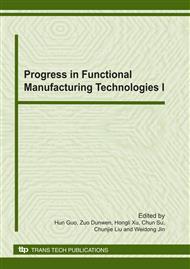p.192
p.200
p.206
p.212
p.218
p.224
p.231
p.237
p.246
Moving Character Analysis of a Novel 3-DOF Parallel Mechanism
Abstract:
A novel 2-TPR/1-SPR spatial 3-DOF parallel mechanism is studied. The studied mechanism is composed of a moving platform connected to a fixed platform by means of three actuated limbs. The two of the three limbs are TPR serial manipulators and the other one is SPR serial manipulator. Each TPR limb consists of a Hoke joint T connecting to the fixed platform, a prismatic pair P, and a revolute pair R connecting to the moving platform. The SPR limb consists of a spherical pair S connecting to the fixed platform, a prismatic pair P, and revolute pair R connecting to the moving platform. Moving character of this mechanism are analyzed by using the theory of screws. The moving platform of this mechanism has one translational DOF, and it is translational moving along the normal direction of the plane which passes through the moving platform. The moving platform of this mechanism also have two rotational DOFs, and they are rotational moving that are rotated the lines which intersect each one of three binding line-vectors of the mechanism at the same time.
Info:
Periodical:
Pages:
218-223
Citation:
Online since:
December 2010
Authors:
Price:
Сopyright:
© 2011 Trans Tech Publications Ltd. All Rights Reserved
Share:
Citation:


